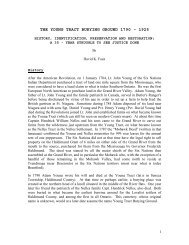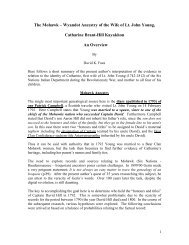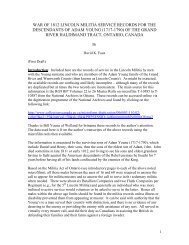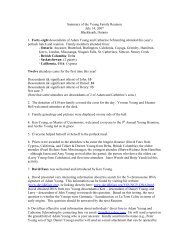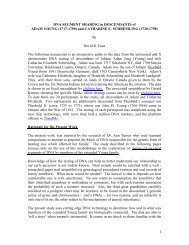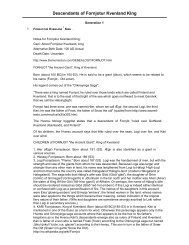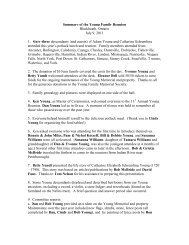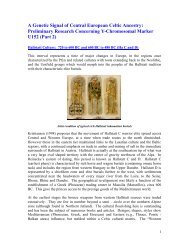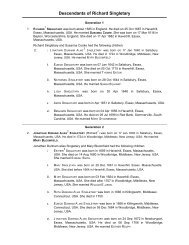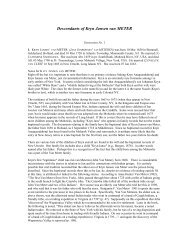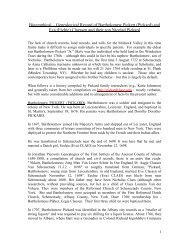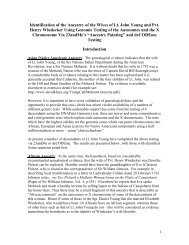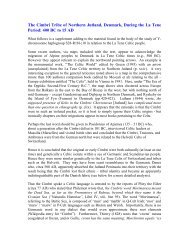Descendants of Hughes I de Cavalcamp Seigneur ... - Davidkfaux.org
Descendants of Hughes I de Cavalcamp Seigneur ... - Davidkfaux.org
Descendants of Hughes I de Cavalcamp Seigneur ... - Davidkfaux.org
You also want an ePaper? Increase the reach of your titles
YUMPU automatically turns print PDFs into web optimized ePapers that Google loves.
Generation 4 (con't)<br />
himself may have been son <strong>of</strong> a seigneur <strong>of</strong> Pirou-unpublished sources are cited,<br />
but it appears to rely mainly on common use <strong>of</strong> the not-uncommon name<br />
Bigot/Bigod, and in part on the conjecture that Roger was a royal steward by<br />
shared inheritance with William <strong>of</strong> Pirou. Both men subscribed a charter <strong>of</strong> William<br />
II for Bath priory, along with three others who held the same <strong>of</strong>fice, Cartul S Petri<br />
Bath 41-42, dated 27 Jan 1090 (but written in 1091, Reg Regum Anglo-Norm i 81<br />
no 315): Ego Eudo dapifer.+. Ego Ivo dapifer.+. Ego Hamo dapifer.+. Ego<br />
Rogerus dapifer.+. Ego Willelmus dapifer.+.<br />
There is no direct evi<strong>de</strong>nce adduced in the COEL database for such a family<br />
connection, although the <strong>of</strong>fice may well have been hereditary in each case.<br />
Roger´s son William was serving with three <strong>of</strong> the same men twenty-five years<br />
later, Matth Paris Chron vi 37 Additamenta no 22, witnesses to charter <strong>of</strong> Henry I<br />
dated 28 Dec 1116 (but written in 1115, Reg Regum Anglo-Norm ii 127 no 1102):<br />
Eudo dapifer, Haimo daipifer [sic], Willelmus Bigot daipifer [sic], Willelmus <strong>de</strong> Piron<br />
alius dapifer. Wace stated that the ancestor <strong>of</strong> Roger´s son Hugo had served Duke<br />
William II as steward by tenure in fee, Wace ii 370:<br />
L´ancestre Hue le Bigot ...<br />
Le duc soleit en sa maison<br />
Seruir d´une seneschaucie ...<br />
En fieu esteit sis seneschals.<br />
8 Sep-Carte Thetford 153 no 9, fragment <strong>of</strong> the history <strong>of</strong> Thetford priory written<br />
early in the 15th century: Hæc omnia facta sunt octavo die ante Nativitatem<br />
beatæ Mariæ, fundamentum scilicet inceptum ... Nam præfatus Rogerus<br />
[Bigotus] octavo die a fundamento incepto vitam terminavit apud Ercsam, novo<br />
nunc castro nominato-this refers to the subjection <strong>of</strong> the priory to Cluny on<br />
Sunday 1 Sep 1107, see n 4 above, originally as a <strong>de</strong>pen<strong>de</strong>ncy <strong>of</strong> Lewes; Roger<br />
died on the octave (or eighth day inclusive) <strong>of</strong> his charter, 8 Sep, the feast <strong>of</strong> the<br />
Nativity <strong>of</strong> the Blessed Virgin Mary. There is no reason to doubt the accuracy <strong>of</strong><br />
the tradition on this important point, when nothing is ma<strong>de</strong> <strong>of</strong> the coinci<strong>de</strong>nce<br />
between Roger´s <strong>de</strong>ath and the <strong>de</strong>dicatee´s liturgical birthday. It is unlikely that<br />
the ceremonial occasion with the king and three bishops present at Thetford took<br />
place not on a Sunday but on the following Tuesday, 3 Sep, as results from<br />
ascribing Roger´s <strong>de</strong>ath on the octave to 10 Sep. Ord Vit Hist vi 144-146, after<br />
reporting the <strong>de</strong>ath <strong>of</strong> Maurice, bishop <strong>of</strong> London, in Sep 1107: Tunc optimates<br />
Angliæ Ricardus <strong>de</strong> Raduariis et Rogerius cognomento Bigotus mortui sunt ...<br />
Super Rogerium Cluniacenses alonaxdi tale scripserunt epitaphium:<br />
Clau<strong>de</strong>ris exiguo Rogere Bigote sepulchro<br />
Et rerum cedit portio parua tibi ...<br />
Soli nubebat uirgo ter noctibus octo<br />
Cum solis morti <strong>de</strong>bita morte tua.<br />
Chibnall noted, ibid 147 n 4, `the epitaph implies 10 September, since the sun<br />
entered Virgo on 18 August according to the table used in western Europe at this<br />
date´. However, ter noctibus octo here more probably meant an overlapping<br />
series <strong>of</strong> three liturgical octaves from Sunday to Sunday (18-25 Aug, 25 Aug-1<br />
Sep, 1-8 Sep) rather than the twenty-fourth consecutive night <strong>of</strong> the astrological<br />
episo<strong>de</strong>, so that 8 Sep is indicated-cf a mid-12th century occurrence <strong>of</strong> the same<br />
phrase, in the speech <strong>of</strong> a physician trying to persua<strong>de</strong> a monk to lend his fur<br />
coat for the sake <strong>of</strong> an ailing king, Nivard Ysengr 338:<br />
Dixeris hec contra quicquam, ter noctibus octo<br />
Non repetes punctum commoditatis i<strong>de</strong>m!<br />
These lines were translated by the editor, ibid 339, `Say what you like against<br />
this, you won´t find such a <strong>de</strong>gree <strong>of</strong> complaisance for a month to come!´-but a<br />
calendar month had no more relevance to a monk´s life than the number twentyfour,<br />
and it appears instead to be a poetic way <strong>of</strong> saying three octaves <strong>of</strong> nightly<br />
prayer (when the coat would be especially nee<strong>de</strong>d), fitting metrically as the literal<br />
`tribus hebdomadibus noctium´ does not.



